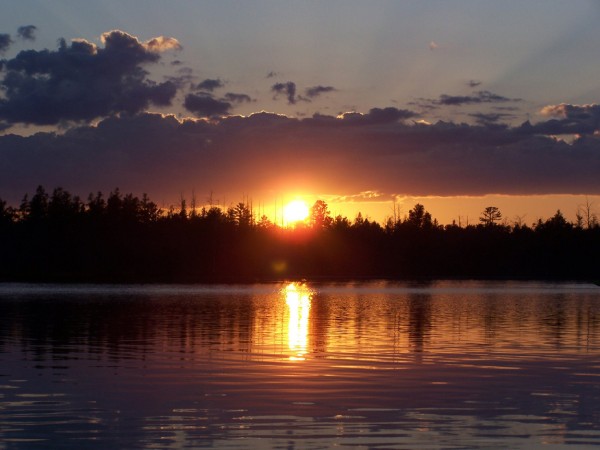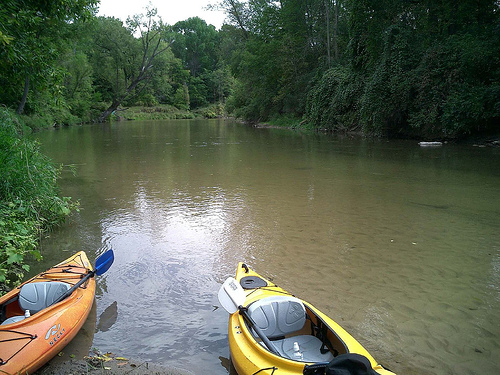
With a 60-mile mainstream and 140 miles of tributaries, the Rifle River is a large watershed and a favorite of canoeists and fishermen. Photo: Michigan DNR
Editor’s note: This story appeared in Michigan River News and is republished here with permission.
By Brian Bienkowski
A conservation group is trying to unload the Rifle River of excess pollutants before the health of the watershed takes a turn for the worse.
Grayling-based Huron Pines and partners are tackling the overloaded river using a three-pronged approach: create a working plan to manage the river and its watershed; restore habitat along the river; and organize stewardship programs to sustain the efforts.
The river is meeting most state environmental and recreational standards, but it is threatened by surplus nutrients and sediment that can throw river systems out of balance, said Abigail Ertel, watershed project manager with Huron Pines. The project is designed to stop pollutants before they worsen.
The effort also contributes to broader regional restoration efforts. The river is linked to a site on a federal list of especially degraded Great Lakes rivers and bays called Areas of Concern.
 “Because the Rifle River feeds into Saginaw Bay, an Area of Concern, efforts to reduce sediment and nutrient loading will assist in the efforts to improve Saginaw Bay,” Ertel said.
“Because the Rifle River feeds into Saginaw Bay, an Area of Concern, efforts to reduce sediment and nutrient loading will assist in the efforts to improve Saginaw Bay,” Ertel said.
Starting in Ogemaw County and flowing southeast into Saginaw Bay, the Rifle River meanders through farms that contribute to the river’s oversupply of nitrogen and phosphorous through fertilizer runoff. This nutrient loading causes algal blooms, decreased oxygen, loss of fish and other ecological damage.
The river also is threatened by excess sediment from livestock grazing and erosion. Sedimentation transports pollutants into the river, causes water levels to fluctuate and increases the water’s temperature, which is bad for fish.
In response, Huron Pines applied for and received $382,000 from the federal Great Lakes Restoration Initiative, which will be added to an estimated $178,000 from other partners.
Making a plan
The three-year project began earlier this year when a committee of local officials, scientists, land conservation professionals, and agricultural experts assembled to pool resources and knowledge of the watershed.

Kayaks on the Rifle’s bank near Omer, Mich. Photo: Naoko McCracken via Flickr
The goal is to find sources of pollution and identify the most sensitive areas of the river, something not accomplished by previous restoration efforts that weren’t coordinated across agencies.
“A number of problem sites and resource threats that were identified in the late ‘90s have been addressed, but there isn’t a good record of what has been restored and where,” Ertel said.
Most of the project’s on-the-ground action will take place in the final two years. After priority areas are determined, the next steps are habitat improvement through land preservation, restoring the most eroded sites and planting riverside strips of vegetation that will guard against polluted runoff.
Huron Pines and partners will help local farmers adopt agricultural practices that do the least amount of harm to water quality and local habitats.
Outlasting the funding
The final part of the project is to reach out to the community and officials to promote environmental stewardship and policies that will help sustain the efforts to protect the river. This outreach will help the project outlast the funding, according to Greg Eagle, land protection specialist with the Saginaw Basin Land Conservancy, a project partner that will spearhead landowner outreach efforts.
“We’re really offering information to landowners within the watershed to educate them about options for managing their land,” Eagle said.
The organization will also encourage landowners within the basin to consider conservation easement agreements, Eagle said. The easements restrict a landowner’s development rights but can lead to lower taxes. By preserving land, the project will save habitat crucial to river health.
The project comes on the heels of an assessment (PDF) that pinpointed problems in the Rifle River watershed and is one of several dozen river-related projects in Michigan that received funding from the initiative’s first round of grants.
With a 60-mile mainstream and 140 miles of tributaries, the Rifle River is a large watershed and a favorite of canoeists and fishermen.
“The work for this project will be completed by September of 2013,” Ertel said. “But goals of the project are to ensure that community leaders and local residents are invested in the project’s long-term success and encourage the continuation of the programs.”
Great observations, Harold– the Rifle is lucky to have a steward like yourself! After reading the assessment, I think many of these eroding sites that are being looked at for restoration are road and stream crossings where significant sedimentation is occurring. As for the natural erosion, I can’t say for sure.
I’ve canoed the entire length of the Rifle River and it is, indeed, a beautiful river. Protecting land in the watershed and along the river will do the most good. I do have a concern about “restoring” eroded sites. There is not much of an erosion problem along the Rifle River, but there are some spots where the banks have eroded and are now exposed. These are not “problem” areas, but are essential areas where Bank Swallows and Belted Kingfishers nest (and which are vital to a number of other species, as well). Erosion is a natural process and should not be considered “pollution”. It is only in highly developed watersheds where sediment loading becomes a serious issue, and even then any remediation efforts need to be balanced with the need to protect essential habitat. Tread lightly with the Rifle River. Keep it natural and understand its natural functions.